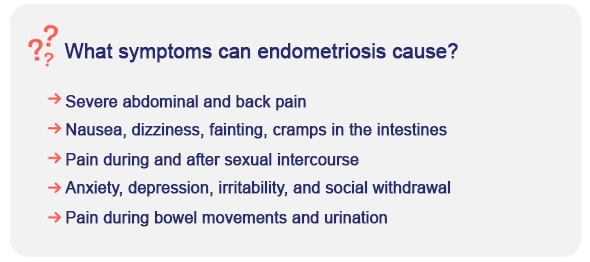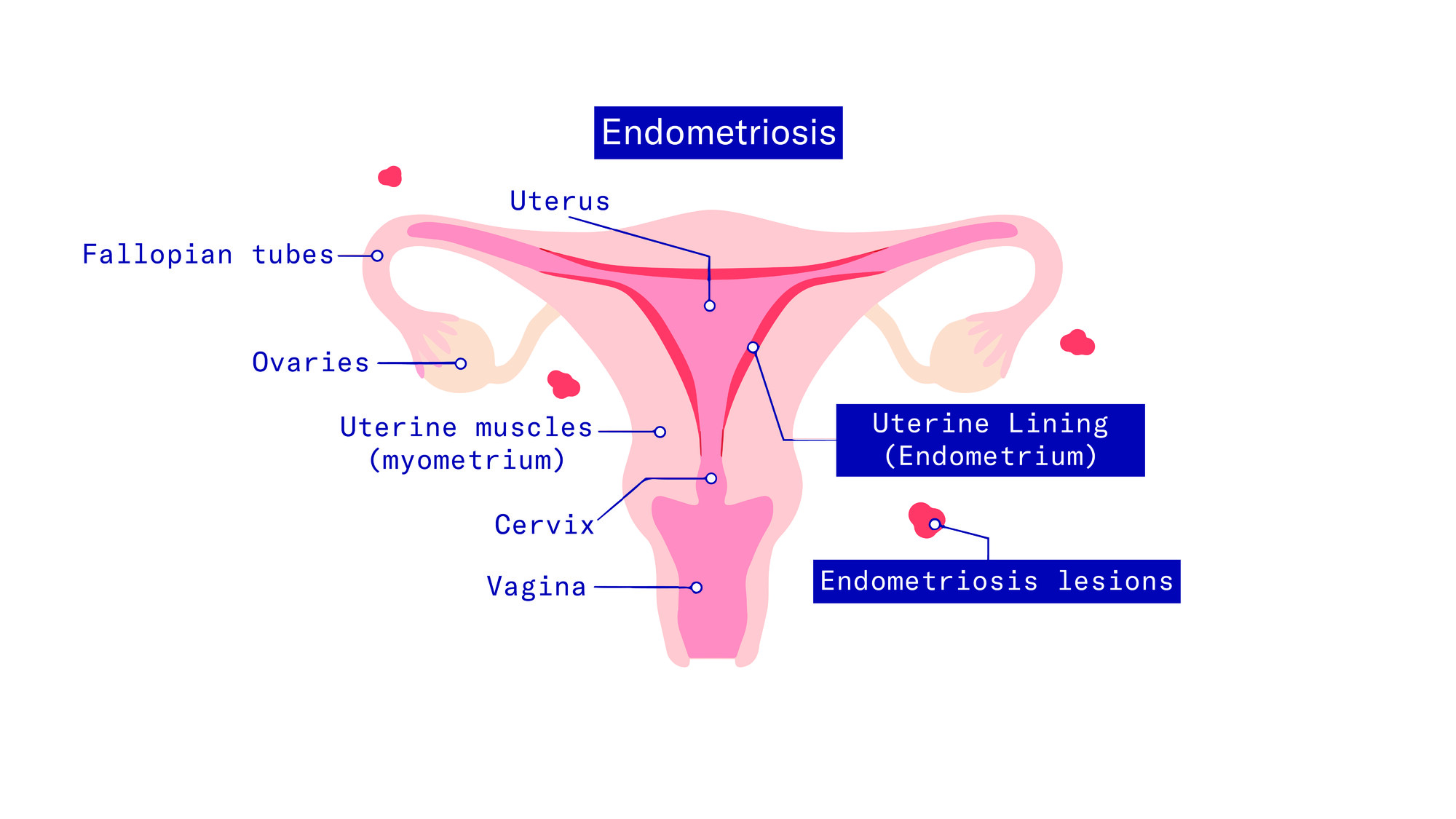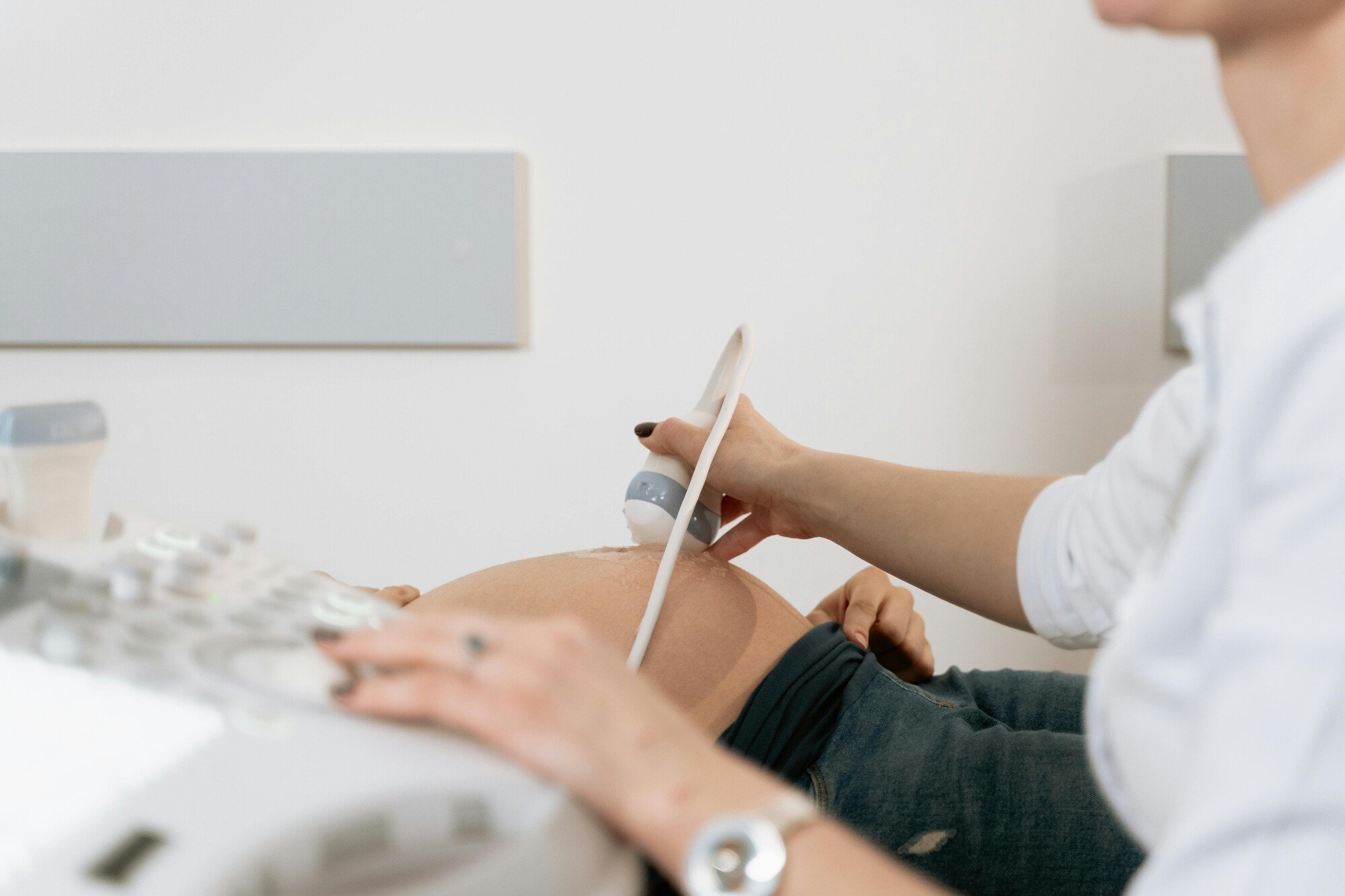What Are the Typical Signs of Endometriosis?
Endometrial cells can migrate to various tissues, causing endometriosis — from deeper layers of the uterus to the vaginal tissue, ovaries, bladder, bowel, lungs, or even the brain. There is, therefore, no such thing as “one single” form of endometriosis [1, 2].
The symptoms largely depend on the location of the endometrial tissue. In some cases, the condition causes no symptoms at all, meaning asymptomatic endometriosis is also possible [1, 2].
Symptoms During the Menstrual Cycle
What is typical, however, is that many of the symptoms occur in connection with the menstrual period. The endometrial cells respond to the female hormone cycle. Under the influence of oestrogen, they multiply — an important clue when investigating symptoms [3, 4].
The most common symptom is lower abdominal pain linked to the period, which often begins before menstruation starts, intensifies steadily, and subsides with the onset of bleeding [3, 4].
However, symptoms can also occur independently of the menstrual cycle, which makes diagnosis even more complicated. Menstrual bleeding can be heavier, lighter, longer, irregular, or completely absent [3-5].
And these are just some of the possible symptoms. Nausea, vomiting, diarrhoea, or even fainting are also common. For those affected and their doctors, this often presents a considerable challenge [3-5].
Symptoms of Endometriosis in the Uterus
When endometrial-like cell clusters leave the uterine lining (the endometrium) and migrate into deeper layers of the uterus, this can lead to a wide range of symptoms [3, 4].
These include severe menstrual pain linked to the period, often starting about two days before menstruation, increasing in intensity as the period approaches, and subsiding with the onset of bleeding [3, 4].
Heavy menstrual bleeding can also be a symptom of endometriosis affecting deeper layers of the uterus. In fact, the depth of infiltration is directly associated with the severity of bleeding [3, 4].
In addition, this type of endometriosis can lead to prolonged menstrual bleeding lasting more than seven days (menorrhagia) or irregular bleeding or continuous spotting outside the expected menstrual phase (metrorrhagia) [3, 4].
Pain during sexual intercourse, reduced fertility, and difficulties during pregnancy are also possible with endometriosis in this location [3, 4].
Signs of Endometriosis in the Digestive Tract
Endometrial cells can also migrate to the gastrointestinal tract, leading to digestive symptoms [3, 4].
These include difficulties with bowel movements (dyschezia), which may present as either constipation or diarrhoea. Diarrhoea can also occur in sync with the menstrual cycle, though irregular diarrhoea unrelated to the cycle is also possible [3, 4].
Visible blood in the stool (hematochezia) or extremely dark stools can likewise be signs of endometriosis affecting the gastrointestinal tract. Other possible symptoms include nausea, vomiting, bloating, a feeling of pressure, and cramps [3, 4].
As with other forms of endometriosis, one of the greatest challenges is that these symptoms are not specific to the condition. Often, only the overall pattern of complaints provides clues for diagnosis [3, 4].
Bladder Symptoms Caused by Endometriosis
When endometriosis affects the bladder, symptoms may resemble those of a common urinary tract infection [3, 4].
These can include lower abdominal pain, difficulty, or even pain when emptying the bladder (dysuria), and frequent urges to urinate — sometimes with only small amounts of urine being passed (pollakisuria) [3, 4].
Blood in the urine is also possible, although the amount is usually too small to be visible to the naked eye. A simple urine test can help detect this [3, 4].
Other Possible Locations
While endometriosis most commonly affects areas close to the reproductive organs, in theory, cell clusters can appear almost anywhere in the body [3, 4].
In addition to the uterus, ovaries, pelvic cavity, vagina, abdominal lining, bladder, and digestive tract, other potential locations include the belly button, ureters, lungs, diaphragm, brain, and even surgical scars [1, 3, 4].
This makes diagnosis even more complex. Especially in unclear cases, doctors should always keep endometriosis in mind as a possible cause [3, 4].
Symptoms in the Diaphragm
When endometriosis affects the diaphragm, it can cause pain on the affected side of the chest, as well as radiating pain into the shoulder, arm, or neck. The pain is often irregular and occurs independently of physical exertion [18].
In very rare cases, endometriosis can lead to a tear in the diaphragm or the entry of air into the so-called pleural cavity. Both conditions impair breathing and can cause shortness of breath [18].
Symptoms in the Lungs
Outside the pelvic area, endometriosis most commonly occurs in the chest, where it can also affect the lungs [18].
Typically, noticeable symptoms only arise if endometrial tissue affects the airways — which can result in coughing up blood — or if a lung collapses due to air entering the pleural cavity (pneumothorax) [18].
In the latter case, symptoms such as chest pain or pain near the shoulder blade may occur. Shortness of breath is also common in this — fortunately rare — scenario [18].
These symptoms usually appear within 72 hours before the start of menstruation. However, that does not mean the symptoms occur with every period. There can be months or even years between such episodes [18].
Endometriosis and Its Impact on Mental Health
For those affected, endometriosis can be a significant challenge — both physically and mentally. In addition to the physical symptoms, the psychological burden plays a major role [5, 6].
The often long and exhausting journey from doctor to doctor can be mentally draining. Many people develop anxiety or start to believe that their symptoms are “all in their head". Of course, the opposite is true [5, 6].
Other challenges are more indirect. Endometriosis has been shown to negatively affect work productivity. A demanding job can become even more stressful as a result. In addition, around half of all individuals with endometriosis report pain during sexual intercourse. Beyond the physical discomfort, this can lead to feelings of shame, avoidance of intimacy, and relationship conflicts [3, 7].
Typical Signs of the Disease at a Glance
The most common symptoms of endometriosis include [3, 4]:

Other possible signs of the condition include [3, 4]:
- Heavy menstrual bleeding
- Prolonged menstrual periods (lasting more than 7 days)
- Irregular or continuous bleeding outside the expected menstrual phase
- Reduced fertility
- Complications during pregnancy (miscarriage, premature rupture of membranes, growth restrictions, premature birth)
- Difficulty with bowel movements (constipation or diarrhoea)
- Visible blood in stool
- Extremely dark-coloured stool
- Vomiting
- Bloating
- Abdominal pressure or cramping
- Lower abdominal pain
- Difficulty or pain when urinating
- Frequent urge to urinate — sometimes with only small amounts of urine
- Blood in the urine
- Headaches
- Radiating pain into the legs
- Fatigue
- Frequent infections
- Slightly elevated body temperature
- Blood when coughing
- Breathing difficulties
- Shoulder pain
Endometriosis While Taking the Pill
Endometriosis cells respond to hormonal fluctuations throughout the menstrual cycle. It does not matter whether these cells are located in the uterine lining as intended, or outside of it — as is the case with endometriosis [3].
A rise in estrogen levels triggers the growth of endometrial cells. Therefore, hormone-based treatments, particularly the use of the contraceptive pill to lower estrogen levels, play a central role in the management of endometriosis [3, 8].
The medications used include progestins, GnRH analogues, combined oral contraceptives, and aromatase inhibitors, with progestin therapy generally being the preferred option [8].
By inhibiting estrogen-dependent growth, these treatments can effectively reduce the size of endometrial lesions and suppress their activity [8].
However, the precise treatment approach should always be determined on an individual basis and in consultation with the treating physicians [8].
Endometriosis in the Desire to Have Children and Pregnancy
Anyone with a known diagnosis of endometriosis and a desire to have children should consult their gynaecologist in advance. Depending on the severity and location of the endometriosis, the associated risks can vary greatly — from negligible to significant [9, 10].
Endometriosis may affect both fertility and the course of a later pregnancy [9, 10]. For example, if endometrial lesions are located deep within the uterine wall, studies show that the probability of becoming pregnant may be reduced by up to 30%. However, these are only average values — every case is unique [3].
If a couple experiences difficulties conceiving, this is not necessarily due to endometriosis. A wide range of other possible causes must also be considered [9]. That is why it is important to thoroughly investigate both fertility-related factors and the nature and extent of endometriosis in each individual case [9, 10].
In many cases, even if pregnancy occurs, there is no increased risk. In fact, hormonal changes during pregnancy often lead to a significant reduction in endometriosis-related symptoms [9, 10].
However, if endometrial lesions are located unfavourably, complications may arise. These can include miscarriage, growth restriction of the fetus, premature rupture of membranes, or preterm birth [3].
Fortunately, gynaecologists can usually assess these risks in advance — and in the vast majority of cases, give the all-clear [9, 10].
Interestingly, this improvement in endometriosis symptoms can, in some cases, persist even after pregnancy [2, 11].
The Clinical Picture During the Menopause
Endometriosis typically develops with the onset of menstruation and most frequently causes symptoms between the ages of 20 and 40. With the arrival of menopause, symptoms usually subside. However, there are exceptions to this rule [2, 5, 12].
In some cases, endometriosis can remain an active condition even after menopause. According to studies, around 2% of individuals diagnosed with endometriosis via surgery received their first diagnosis after menopause [13].
Nevertheless, severe disease progression at this stage of life remains extremely rare. This is primarily due to the natural decline in estrogen levels associated with menopause [13].
Diagnosis: Are There Tests to Detect Endometriosis?
Unfortunately, there is no single test that can reliably diagnose endometriosis. On average, it takes about six years from the first symptoms to a confirmed diagnosis. For women with severe pain symptoms, this period can extend to ten years [19, 20].
There are many reasons for this delay. One major factor is the wide range of possible symptoms, which are not necessarily present in every case. For example, one woman with endometriosis might mainly experience shoulder pain, while another suffers from digestive issues, making it difficult for both patients and doctors to identify the condition early on [5].
Often, affected women initially consult doctors from other specialities. Orthopaedists, gastroenterologists, and others rarely arrive at the correct diagnosis promptly. Even many gynaecologists miss early detection due to the busy nature of their practices and because gynaecological exams frequently show no abnormalities. This is because endometriosis lesions are usually deeply embedded in tissue [5].
While the often cyclical nature of symptoms can be an important clue, it is not always present. Especially in women taking the pill, cyclic peaks in estrogen levels are absent, which can cause the growth and pain symptoms of endometriosis lesions to become uncoupled from the menstrual cycle [5].
If endometriosis is suspected, it is crucial that patients be referred to a specialized centre. Through thorough medical history, examinations, various imaging techniques, and sometimes surgical biopsies, a reliable diagnosis can be established [19].
Treatment of Symptoms
Currently, it is not possible to cure endometriosis completely. However, there are both medical and surgical treatment options available [14].
Once diagnosed, treatment is best managed at a specialized centre with an interdisciplinary team. This means that doctors from various specialities collaborate closely, which is important since endometriosis can affect many different parts of the body [14].
Over time, a so-called “pain memory” can develop. When the spinal cord and brain repeatedly receive strong pain signals, their processing can adapt, resulting in sensitization. This can amplify pain perception independently of the treatments performed [5, 6, 15].
Techniques such as keeping a symptom diary, yoga, wellness therapies, acupuncture, as well as neural therapy, pain therapy, physiotherapy, and psychotherapy can be very effective in managing symptoms [5, 6, 15].
Endometriosis remains a complex condition, but the number of research publications on it is rapidly increasing [16, 17]. This could lead to promising breakthroughs in the near future.
The contents of this article reflect the current scientific status at the time of publication and were written to the best of our knowledge. Nevertheless, the article does not replace medical advice and diagnosis. If you have any questions, consult your general practitioner.
Originally published on







